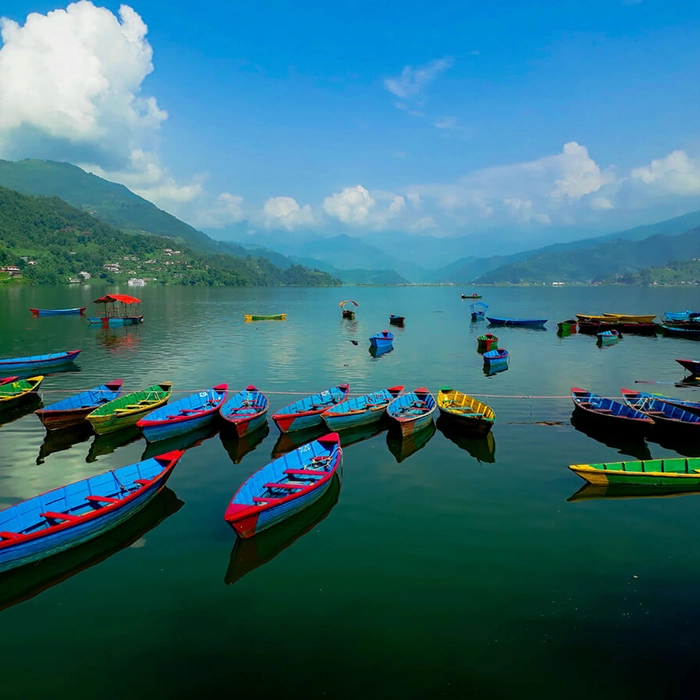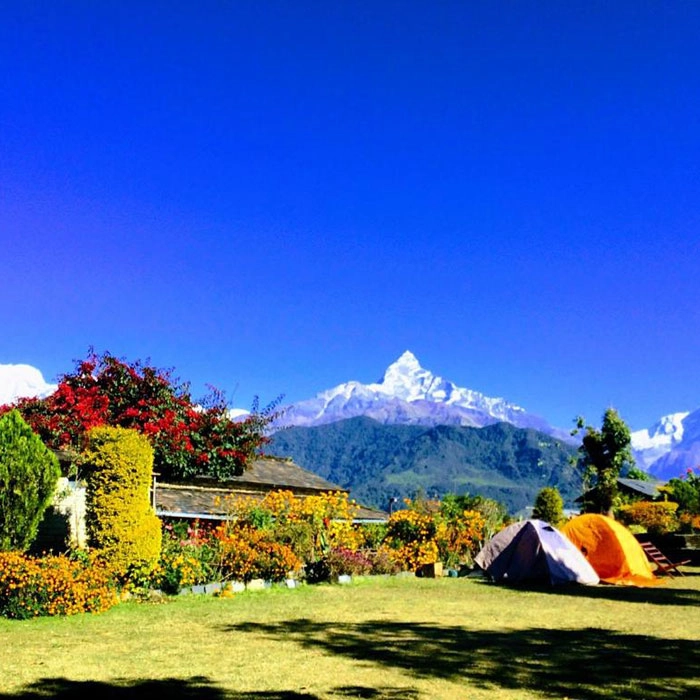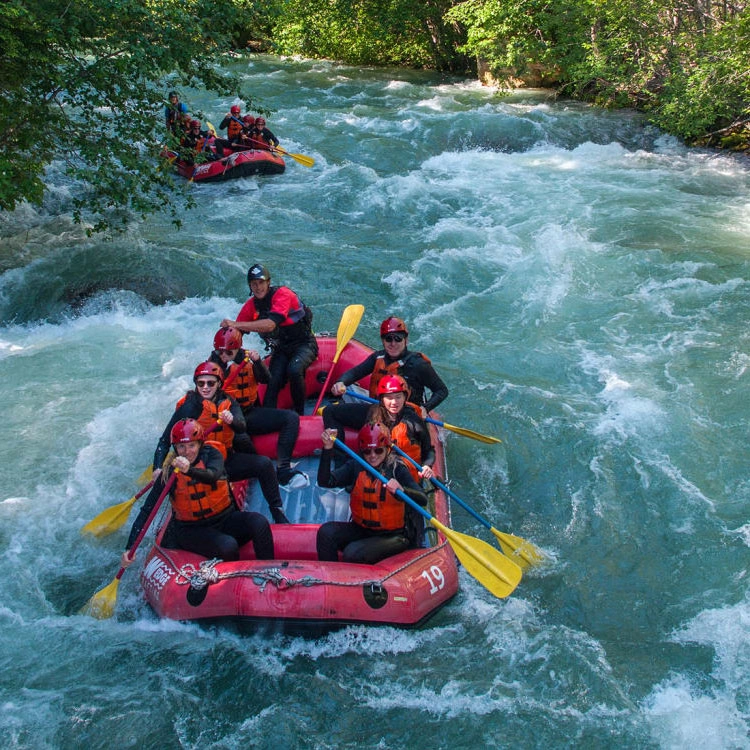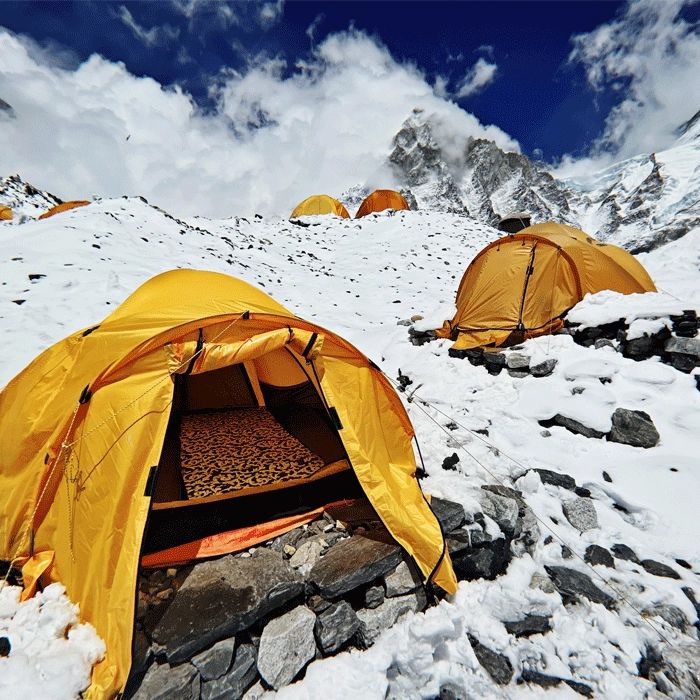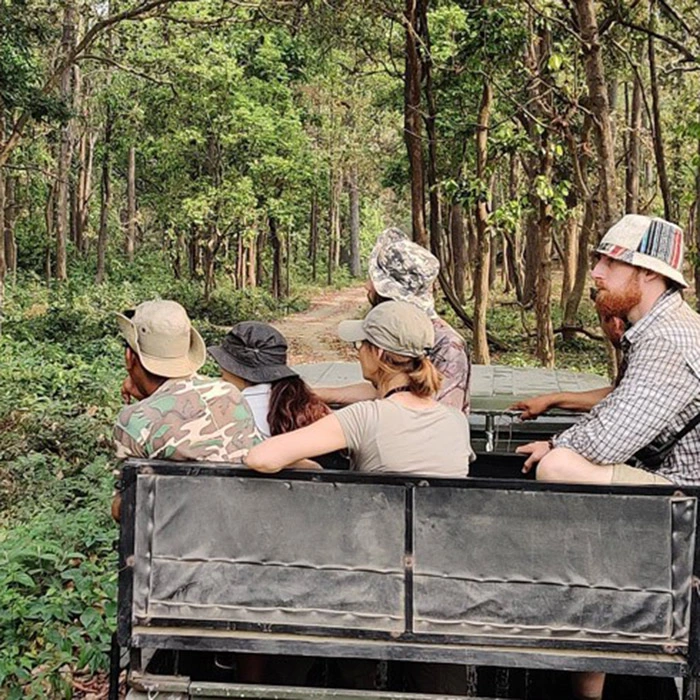MARDI HIMAL TREK
US$1,710.00
/pp
-
14 Days
-
Annapurna
-
Spring/Autumn
-
Trekking
-
4,500 Meters
-
Moderate
-
Bus / Plane
-
01-16 People
-
JH#218
 Overviews
Overviews
Join Jagadamba Holidays for the Mardi Himal Trek, a premier trekking adventure in Nepal’s Annapurna region. This trek is famous for its breathtaking views and peaceful setting, making it an excellent choice for those seeking a memorable journey. Your Mardi Himal Trek adventure starts in the beautiful Pokhara Valley, known for its serene lakes and stunning mountain views. From here, the trek takes you through lush rhododendron forests, charming villages, and scenic terraced fields. Each day brings new and amazing sights, showcasing the diverse beauty of the Annapurna region. A notable highlight of Mardi Himal Trek trek is the chance to experience a stay in the picturesque village of Lwang. Here, you’ll have the chance to stay with a local Gurung family. This unique experience provides a genuine look at their traditional lifestyle and warm hospitality, making your trek even more special. As you hike towards Mardi Himal Base Camp, located at about 4,500 meters, you’ll enjoy incredible panoramic views of Mardi Himal and the surrounding peaks. This tranquil spot is a perfect escape from the busier trails, letting you fully enjoy Nepal’s natural beauty. Throughout the trek, you’ll also interact with the friendly Gurung and Magar communities. Their rich cultural traditions and welcoming nature add depth to your adventure, offering a richer understanding of the local culture. Whether you’re an experienced trekker or just looking for a peaceful getaway, the Mardi Himal Trek with Jagadamba Holidays promises a fantastic experience. Explore one of Nepal’s most beautiful and less-traveled trails, combining stunning vistas with meaningful cultural encounters for an exceptional adventure. Mardi Himal Trek DifficultyThe Mardi Himal Trek is considered a moderate trek, making it ideal for both beginners with good fitness and experienced trekkers seeking a quieter route. The trail involves daily hikes of 4 to 6 hours, ascending gradually through forests, ridgelines, and alpine landscapes up to a maximum altitude of around 4,500 meters (14,763 feet) at Mardi Himal Base Camp. While the trek doesn't require technical climbing skills, some steep and narrow sections may be physically demanding. With proper pacing and acclimatization, the Mardi Himal Trek is a rewarding and manageable adventure offering breathtaking mountain views without extreme difficulty. Mardi Himal Trek CostThe Mardi Himal Trek cost typically includes a licensed trekking guide, porter assistance, conservation area and TIMS permits, teahouse accommodation, all meals during the trek, and ground transportation to and from the trailhead. Solo trekkers benefit from personalized attention, while groups enjoy tiered discounts, with prices per person decreasing as group size increases. We also provide special seasonal discounts during the quieter months to make this serene Himalayan experience even more accessible. While our website lists standard international rates, you can contact us directly for private group options, and we'll ensure you receive the most competitive pricing without compromising on quality of service.
 Itinerary (Plan)
Itinerary (Plan)
Arrive in Kathmandu (1,400 m / 4,593 feet), Nepal's vibrant capital, where you'll be warmly welcomed with marigold garlands. After transferring to your hotel, take time to relax and acclimate to the bustling city. Discover vibrant local markets, indulge in traditional Nepali dishes, and delve into Kathmandu's rich cultural tapestry. This initial day is perfect for easing into your journey, setting the stage for the exciting adventures ahead in Eastern Nepal. A representative from Jagadamba Holidays will ensure a smooth and pleasant arrival.
Optional Evening Activity:
If you wish, you can spend your evening experiencing the Pashupatinath Aarti, a captivating religious ceremony held at the Pashupatinath Temple. The Aarti usually begins around 6:00 PM and lasts for approximately an hour. This ceremony is a mesmerizing display of traditional music and rituals, providing a profound insight into Hindu spiritual practices. Please check the exact time for the Aarti on the day of your visit, as it may vary. This option is not included in the standard itinerary but offers a unique opportunity to immerse yourself in local culture.
Your journey begins with a scenic drive to Pokhara, a picturesque city nestled beside the serene Phewa Lake. The drive typically takes around 6-7 hours, covering approximately 200 kilometers from Kathmandu. For a more time-efficient and scenic travel experience, consider opting for a short 30-minute flight from Kathmandu to Pokhara instead of the 6-7 hour drive. This premium option, available at an additional cost, offers a breathtaking aerial view of the Himalayan landscape, ensuring a more comfortable and memorable journey.
As you leave the bustling capital, the road winds through lush green hills, terraced farmlands, and charming villages, offering a glimpse of rural Nepalese life. Enjoy the tranquil atmosphere of Pokhara, with the majestic Annapurna range standing tall in the backdrop. This city is the gateway to your trekking adventure, so take time to relax and prepare for the thrilling days ahead.
After a hearty breakfast at your hotel in Pokhara, you will meet your trekking guide and porter. Then, embark on a scenic jeep ride to Kande (1,770 m / 5,807 ft), the official starting point of the Mardi Himal Trek in the Annapurna region. The drive takes approximately 40 minutes, covering a distance of about 31 km from Pokhara to Kande, offering scenic views along the way. Along the route, you will pass through terraced hillsides, traditional farming villages, and lush green valleys, offering an authentic first glimpse of Nepal’s Himalayan countryside. From Kande, the trek begins with a steady uphill climb through rhododendron and oak forests, passing by terraced farmland and traditional homes. After about an hour of ascent, you’ll reach the Australian Camp (2,065 m / 6,775 ft), a stunning viewpoint with sweeping vistas of the Annapurna range, including Annapurna South, Hiunchuli, and the iconic Machapuchare (Fishtail Mountain). This spot is perfect for a short rest, refreshments, and photography. The trail then continues gradually along forested ridgelines and open meadows before reaching Deurali (2,100 m / 6,889 ft). Covering approximately 6 km (3.7 mi) in 4–5 hours, this trek involves an ascent of about 1,278 meters with a few short descents of around 100 meters. The route beautifully combines natural scenery with encounters in quiet mountain villages, making the day both culturally immersive and visually rewarding. Your day ends with an overnight stay at Pitam Deurali, where welcoming teahouses provide hot meals and cozy rooms. From here, you can enjoy the serene Himalayan atmosphere and witness a breathtaking sunset over the Annapurna range, preparing for the adventure ahead.
After enjoying a hearty breakfast at the lodge in Pitam Deurali, trekkers begin their rewarding journey toward Forest Camp (2,600 m / 8,530 ft)—a peaceful stop nestled deep within the Annapurna region along the Mardi Himal Trek. This section is renowned for its quiet trails, pristine natural surroundings, and the sense of seclusion it offers compared to busier trekking routes in Nepal. The trek covers approximately 6 kilometers and typically takes 4–5 hours to complete. Along the way, trekkers gain about 600 meters of elevation while descending around 150 meters, making it a moderately challenging day. The route combines steady ascents with short, gentle descents, creating a comfortable walking rhythm while highlighting the untouched beauty of the Mardi Himal trail. Leaving the open landscapes behind, the path steadily climbs into dense forests, immersing trekkers in the serenity of the high Himalayas. This section feels far removed from crowded trekking corridors, offering a peaceful and intimate experience with nature from the very first steps. As the trail progresses, it leads into enchanting rhododendron and oak forests, where the shaded canopy provides cool and refreshing air. In spring, these hillsides burst into color as rhododendrons bloom in brilliant shades of red, pink, and white. The forests are alive with Himalayan wildlife, from the calls of vibrant birds like the Danphe to playful monkeys moving through the trees, with the possibility of spotting more elusive species. The deeper you go, the cooler and calmer the air becomes, complemented by the rhythmic sounds of rustling leaves and chirping birds. Unlike other popular routes in the Annapurna Circuit or Ghorepani, this section of the Mardi Himal Trek offers genuine solitude. With no villages or settlements en route, it feels like a pure immersion into wilderness. Every so often, small clearings in the forest reveal distant glimpses of Machapuchare (Fishtail) and the Annapurna peaks, a preview of the panoramic mountain views that await higher up. Short descents break up the steady climb, providing natural pauses before the trail ascends again through the untouched woodland. Arriving at Forest Camp (Kokar) at 2,600 meters, trekkers are welcomed by a tranquil clearing surrounded by towering trees. The area is home to only a handful of lodges that provide basic but cozy accommodation and warm local hospitality. Its secluded setting makes it an ideal place to rest, recharge, and prepare for the ascent to Low Camp and High Camp, where the forest gives way to dramatic alpine landscapes. More than just a physical climb, this day offers a rejuvenating experience of silence, wilderness, and natural beauty, laying the perfect foundation for the challenges and breathtaking panoramas ahead on the Mardi Himal Trek.
After breakfast at the lodge in Forest Camp (2,600 m / 8,530 ft), trekkers set out on the trail to Low Camp (3,035 m / 9,957 ft). This section of the Mardi Himal Trek rewards hikers with their first up-close views of the Annapurna range and the iconic Machhapuchchhre peak. Though shorter in distance, this stage is highly rewarding, as the dense forests gradually give way to more open landscapes and breathtaking Himalayan vistas. The trek covers approximately 6 kilometers and typically takes 3–4 hours to complete. Trekkers ascend about 500 meters while descending around 100 meters, making it a moderately challenging trekking day suitable for hikers with good fitness levels. The gradual incline, combined with manageable descents, allows trekkers to maintain a comfortable rhythm while acclimatizing to the increasing altitude. The route from Forest Camp begins along shaded trails that steadily climb upward. As trekkers gain elevation, the forest canopy begins to thin, and the surroundings open up to reveal glimpses of towering Himalayan peaks. The path remains well-defined and relatively less crowded, offering a calm and enjoyable trekking experience compared to busier routes in the Annapurna region. For much of the ascent, trekkers pass through stretches of rhododendron, oak, and maple forests, where the cool mountain air and peaceful environment make for a refreshing climb. In spring, the rhododendrons bloom, adding vibrant red and pink colors to the trail. The forest is also home to Himalayan wildlife, including the national bird Danphe, creating moments of quiet connection with nature before the terrain opens up. As the tree line recedes, the views become increasingly dramatic. The majestic Annapurna South and the iconic Machhapuchchhre (Fishtail) rise prominently, glowing brilliantly under clear skies. This section is especially renowned for its solitude and natural beauty, with far fewer trekkers compared to popular routes like Ghorepani or the Annapurna Circuit. Sunset at Low Camp is one of the most memorable moments on the trek. The snowcapped peaks of Annapurna South and Machhapuchchhre glow in golden and crimson light, offering trekkers a breathtaking Himalayan panorama. Upon arrival at Low Camp (3,035 m / 9,957 ft), trekkers are welcomed by a small cluster of lodges offering basic but comfortable accommodations. The peaceful setting, fluttering prayer flags, and panoramic mountain views make it an ideal place to rest and recharge. Low Camp also prepares trekkers for the next day’s climb to High Camp, where the alpine landscape opens up to sweeping views of Annapurna and Dhaulagiri.
After breakfast at the lodge in Low Camp (3,035 m / 9,957 ft), trekkers begin their steep ascent toward High Camp (3,550 m / 11,646 ft), a scenic ridge offering panoramic vistas of the Annapurna range and the surrounding Himalayan peaks. This section of the Mardi Himal Trek takes hikers into the alpine zone, where forests gradually give way to open meadows and rugged mountain landscapes. The climb is both challenging and highly rewarding, providing some of the most memorable views of the trek. The trek journey covers approximately 4 kilometers and typically takes 3–4 hours to complete. Trekkers ascend about 550 meters with minor descents totaling around 50 meters, making this a moderately steep trekking day. The relatively short distance allows hikers to acclimatize properly in preparation for the next day’s journey to Mardi Himal Base Camp. The route from Low Camp begins along well-defined trails that steadily climb through sparse alpine vegetation. As trekkers gain elevation, the scenery transforms dramatically, with grassy ridges and alpine meadows replacing the dense forests of lower altitudes. The path is less crowded than other routes in the Annapurna region, offering a sense of solitude and a direct connection with the Himalayan wilderness. Along the ascent, trekkers are treated to stunning views of Annapurna South, Hiunchuli, Machhapuchchhre, and other towering peaks. Alpine flowers and hardy shrubs dot the trail, adding subtle bursts of color to the rugged terrain. The clear skies and crisp mountain air make this section ideal for photography and quiet contemplation of the vast Himalayan panorama. High Camp is situated on a grassy ridge, providing an excellent vantage point for observing the surrounding mountains. High Camp offers a small cluster of lodges, providing trekkers with simple yet cozy overnight accommodations. From here, trekkers can enjoy sweeping vistas of Annapurna South, Machhapuchchhre, and Mardi Himal, making it a perfect location to rest, acclimatize, and prepare for the trek to Mardi Himal Base Camp the following day. This stage of the trek highlights the transition from forest-covered trails to alpine landscapes, offering a mix of adventure, natural beauty, and panoramic views. The short trekking distance ensures that hikers can take in the scenery, adjust to the altitude, and savor one of the most spectacular sections of the Mardi Himal Trek.
Trekkers wake up early at High Camp (3,550 m / 11,646 ft) and start their day with a light hot drink at the cafeteria near the viewpoint. As they sip their morning beverage, they take in the crisp mountain air, enjoy the serene surroundings, and marvel at the panoramic views of the towering Himalayan peaks stretching across the horizon. After soaking in the breathtaking scenery, they return to the lodge for a hearty breakfast and rest. Following breakfast, trekkers can choose between a challenging day hike to Mardi Himal Base Camp (4,500 m / 14,764 ft) or a rest day at High Camp. This morning routine allows hikers to acclimatize properly while enjoying the peaceful environment and stunning Himalayan vistas. This day presents trekkers with the option of a challenging hike to Mardi Himal Base Camp or a restful day at High Camp, allowing time to acclimatize and enjoy the stunning Himalayan scenery. Trekkers start early, enjoying the crisp mountain air and panoramic Himalayan views before embarking on the ascent. The journey provides a perfect balance of adventure, acclimatization, and scenic immersion in the Annapurna region. The round-trip trek to Mardi Himal Base Camp covers approximately 10 kilometers and typically takes 6–7 hours to complete. Trekkers ascend about 950 meters and descend the same distance back to High Camp, making it a strenuous trekking day suitable for hikers with good fitness levels. The steep and rocky trail requires caution but rewards perseverance with stunning vistas. The trail begins from High Camp and climbs steadily through alpine meadows and rocky paths. As trekkers gain elevation, the terrain opens up to reveal sweeping views of surrounding peaks. The path is well-marked but challenging, with a mix of gradual inclines and steep sections that test stamina and endurance. At this high altitude, the dense forests gradually give way to sparse alpine vegetation, with hardy alpine flowers and shrubs dotting the rugged trail. Wildlife is limited at these elevations, but the crisp mountain air and serene natural surroundings create a peaceful environment for reflection and photography. This section of the Mardi Himal Trek is renowned for its solitude and tranquility, far removed from the busier trails in the Annapurna region. As trekkers ascend, they are treated to unobstructed views of iconic peaks such as Annapurna South, Machhapuchchhre, Hiunchuli, and Mardi Himal. The sweeping Himalayan panoramas and clear blue skies make it an ideal location for nature photography, meditation, and soaking in the majestic alpine scenery. Reaching Mardi Himal Base Camp (4,500 m / 14,764 ft) is a true milestone for trekkers. The breathtaking views of the Annapurna range, Machhapuchchhre, and Mardi Himal reward every step of the climb. After enjoying the awe-inspiring scenery, hikers descend back to High Camp, where cozy lodges provide a well-deserved rest and the perfect setting to recharge before continuing the Mardi Himal Trek.
After a hearty breakfast at High Camp (3,550 m / 11,646 ft), trekkers set out on their scenic return journey toward Forest Camp (2,600 m / 8,530 ft). Retracing the trail provides an opportunity to view the stunning Himalayan landscapes from a fresh perspective, as the path winds through alpine meadows, rocky ridges, and sparse high-altitude vegetation. The descent is gentler than the ascent, allowing trekkers to enjoy a more relaxed pace while still experiencing breathtaking vistas of Annapurna South, Machhapuchchhre, Mardi Himal, and other surrounding peaks. This section combines natural beauty with the satisfaction of retracing a path already conquered, offering moments for reflection and appreciation of the Annapurna region’s unique scenery. The return trek covers approximately 10 kilometers and typically takes 5–6 hours to complete, depending on trekking pace, weather conditions, and time spent at viewpoints. Trekkers descend about 950 meters, with short ascents totaling roughly 100 meters, creating a balanced route that is manageable yet engaging. The gentler downhill sections are ideal for recovering from the higher altitude at High Camp, while the occasional short climbs help maintain a comfortable trekking rhythm. Along the way, hikers can pause frequently to capture photographs, admire panoramic mountain views, and observe the diverse flora and fauna of the region. This stage is perfectly suited for acclimatization, mindful reflection, and immersion in the serene Himalayan environment. As the trail gradually descends, the rugged alpine terrain transitions into lush forests surrounding Forest Camp, where trekkers encounter oak, rhododendron, and maple trees. Hardy shrubs and alpine flowers add vibrant splashes of color along the path, while glimpses of local Himalayan birdlife bring life to the serene surroundings. These quiet forested sections provide a refreshing contrast to the higher-altitude landscapes, giving hikers the chance to pause, breathe, and connect with nature. The return route offers a profound sense of solitude and tranquility, far from the crowded trails of more popular Annapurna destinations. Trekkers enjoy unobstructed views of Annapurna South, Machhapuchchhre, Hiunchuli, and Mardi Himal, now framed differently by the descending trail. This stage is ideal for nature photography, meditation, and appreciating the constantly changing beauty of the Himalayan panorama, making every step a memorable experience. Upon arrival at Forest Camp (2,600 m / 8,530 ft), trekkers are welcomed by a peaceful clearing surrounded by towering trees and rustic lodges. This tranquil stop provides the perfect opportunity to rest, refuel, and reflect on the trek accomplished, while preparing for the next stage of the Mardi Himal Trek or the continued descent toward lower elevations. The combination of natural serenity, breathtaking mountain vistas, and cozy accommodations makes Forest Camp an ideal location to recharge both physically and mentally after the high-altitude journey.
After a hearty breakfast at Forest Camp (2,600 m / 8,530 ft), trekkers begin their scenic descent toward Lwang Village (1,550 m / 5,085 ft). The trail meanders through lush forests, terraced farmland, and picturesque Himalayan landscapes, providing trekkers with a perfect blend of scenic beauty and authentic cultural experiences. As hikers descend, the air gradually warms, and the scenery shifts from alpine meadows and rugged hillsides to lush valleys and cultivated farmland, highlighting the diverse ecosystems of the Annapurna region. The trek covers approximately 12 kilometers and typically takes 5–6 hours to complete. Trekkers descend about 1,050 meters, with short ascents totaling roughly 200 meters, providing a manageable yet engaging journey. The gradual downhill sections allow for a relaxed pace, while the occasional uphill stretches keep the body active and balanced. This combination ensures that trekkers can enjoy the surroundings, capture photographs, and immerse themselves in the local environment without excessive fatigue. Along the route, hikers pass through small, traditional Nepalese villages, where they can experience authentic Gurung culture and observe daily village life. Terraced fields, local farms, and quaint homes provide insight into the agricultural practices and customs of the region. Friendly villagers often welcome trekkers with smiles, offering a glimpse into their daily routines, traditions, and hospitality, making this section of the trek culturally enriching as well as visually rewarding. The trail is lined with forests of oak, rhododendron, and pine, interspersed with terraced farmland and occasional streams and waterfalls. Birdlife and small wildlife are visible along the path, providing further connection to the natural surroundings. The descent allows trekkers to appreciate the contrast between the high-altitude landscapes of Forest Camp and the more temperate, verdant environment near Lwang Village. As trekkers approach Lwang Village, they are greeted by the charm of a traditional Himalayan settlement known for its tea gardens, rustic lodges, and warm local hospitality. The village offers a chance to interact with locals, explore their homes, and learn about Gurung culture, making it a rich cultural stop after the high-altitude trekking experience. The peaceful surroundings, combined with views of distant Annapurna peaks, create a serene and fulfilling end to the day’s journey. Upon arrival at Lwang Village (1,550 m / 5,085 ft), trekkers can relax in the cozy lodges, enjoy local cuisine, and reflect on the trek. The combination of natural beauty, cultural immersion, and gentle trekking makes this section of the Mardi Himal Trek an ideal opportunity to rest and recharge while gaining a deeper understanding of the region’s heritage and way of life.
Today, immerse yourself in the serene charm of Lwang Village. Begin with a visit to the lush tea gardens, where you’ll gain insights into traditional tea cultivation and processing while enjoying stunning panoramic views of the Annapurna range. The verdant fields and rolling hills provide a perfect backdrop for learning about the local tea production methods.
As you wander through the picturesque village streets, you'll have the chance to engage with the friendly locals, experiencing their daily customs and warm hospitality. This interaction offers a unique glimpse into traditional Nepalese village life and its simple, yet enriching, lifestyle.
For a touch of adventure, embark on a scenic trek to nearby waterfalls. The journey takes you through verdant forests and terraced fields, culminating in the breathtaking beauty of cascading falls. Here, you can enjoy a tranquil moment, perhaps take a refreshing dip, and relish the serene surroundings.
In addition to these activities, explore local craft shops for unique souvenirs or visit a traditional Nepalese home for a cooking demonstration. This experience allows you to delve deeper into the local culture and culinary traditions, adding an extra layer of cultural immersion to your day.
Designed for relaxation and cultural exploration, this day offers a perfect balance of leisure and adventure. It’s an opportunity to enjoy the natural beauty of rural Nepal, providing a refreshing contrast to the trekking days and allowing you to unwind and soak in the tranquil ambiance of Lwang. No significant altitude change today as you remain around 1,550 meters, ensuring a leisurely and enriching experience.
After a hearty breakfast at Lwang Village (1,550 m / 5,085 ft), trekkers commence the final stage of the Mardi Himal Trek with a gentle descent toward Khoramukh (1,093 m / 3,586 ft). The trail gently descends through verdant forests and terraced farmland, creating a peaceful and scenic journey. Along the way, trekkers pass bubbling streams, traditional stone walls, and quaint Nepalese homes, offering authentic glimpses into rural life in Nepal. The path is clearly marked and easy to navigate, making this final section of the Mardi Himal Trek both safe and enjoyable. As trekkers descend, the surrounding Himalayan landscapes open up, giving occasional panoramic views of Annapurna South, Machhapuchchhre, and the distant peaks of the Annapurna range, creating perfect photo opportunities along the way. The distance of this segment is approximately 2.3 kilometers, typically taking around 1 hour to complete. The trail descends gently, dropping about 380 meters with no significant ascents, making it a relaxed and scenic conclusion to the Mardi Himal Trek. The combination of verdant forests, terraced fields, and tranquil Himalayan surroundings provides a final immersive experience of the region’s natural beauty and cultural richness. Trekkers can pause along the trail to appreciate the environment, interact briefly with locals, or simply enjoy the peaceful ambiance after the challenging days in higher altitudes. Upon reaching Khoramukh (1,093 m / 3,586 ft), trekkers board a private jeep transfer to Pokhara (822 m / 2,697 ft). The drive covers roughly 20 kilometers and takes about 1 hour, passing through picturesque rivers, farmland, and forested hillsides. This final leg of the journey offers one last opportunity to admire Nepal’s stunning landscapes, including rolling hills, verdant valleys, and distant views of the Annapurna peaks, as the journey transitions from mountainous terrain to the subtropical valley surrounding Pokhara. Once in Pokhara, trekkers can relax and reflect on the remarkable experiences of the Mardi Himal Trek. Pokhara’s calm and scenic environment, centered around the tranquil Phewa Lake, offers an ideal place for trekkers to relax, reflect, and celebrate the completion of their Mardi Himal Trek. Trekkers can stroll along the lakeside, enjoy panoramic views of the surrounding mountains, or simply absorb the peaceful ambiance, taking time to relive the highlights of the trek and the cultural experiences encountered along the trail. The day concludes with a comfortable overnight stay in Pokhara, allowing trekkers to rest, rejuvenate, and celebrate the completion of their journey. This final evening in one of Nepal’s most enchanting cities offers a moment to reflect on the scenic landscapes, alpine adventures, and cultural immersion experienced throughout the Mardi Himal Trek, providing a fitting and memorable conclusion to an unforgettable Himalayan expedition.
After a rewarding trekking journey, today is dedicated to both relaxation and exploration in the charming city of Pokhara (822 m / 2,697 ft.). Begin your day with a peaceful visit to Phewa Lake, where you can enjoy the stunning reflections of the Annapurna range on the tranquil waters. Opt for a leisurely boat ride on the lake to reach Tal Barahi Temple, situated on an island and offering a serene escape.
For expansive views, visit the World Peace Pagoda, a Buddhist stupa perched on a hilltop that provides panoramic vistas of Pokhara Valley and the majestic Himalayas, including the Annapurna and Dhaulagiri ranges. Alternatively, take a short hike to Sarangkot for breathtaking sunrise or sunset views over the Himalayas and a sweeping perspective of the valley.
Explore the vibrant Lakeside area, known for its lively atmosphere, charming cafes, boutique shops, and diverse restaurants. This area is perfect for leisurely shopping, enjoying local and international cuisine, and soaking in the vibrant ambiance.
Enhance your exploration with visits to notable local attractions. Marvel at Devi’s Fall, where the Pardi Khola River plunges dramatically into a deep gorge. Nearby, explore Gupteshwor Cave, a sacred site featuring a significant Shiva lingam and fascinating underground passages. Visit Bindhyabasini Temple, dedicated to the goddess Bindhyabasini, offering spiritual insights and a picturesque setting. Witness the striking Seti Gorge, carved by the powerful Seti River, known for its impressive geological formations. Finally, a trip to Pumdikot provides additional panoramic views and insight into the region’s natural beauty.
This day is crafted for relaxation and comprehensive exploration, allowing you to fully appreciate the tranquility and diverse attractions of Pokhara, marking a perfect conclusion to your trek.
Your adventure concludes with a luxurious and scenic drive from Pokhara to Kathmandu on a deluxe tourist bus. Covering approximately 200 kilometers in 6–7 hours, this comfortable journey takes you through verdant hills, winding roads, and alongside the Trishuli River, offering stunning views of Nepal’s diverse landscapes. As you depart from the lake city of Pokhara, the gateway to the Annapurna region, you’ll pass through traditional Nepali villages, terraced fields, and lush valleys before arriving in Kathmandu, the bustling temple city rich in history, culture, and heritage. This final leg of your Annapurna Base Camp Trek is not just a return trip but a last chance to embrace Nepal’s natural beauty and cultural essence. Upon reaching Kathmandu, spend your time exploring UNESCO World Heritage Sites, shopping for handmade souvenirs, or simply relaxing and reflecting on your unforgettable Himalayan trekking adventure.
Concluding Your Journey in Nepal
As your remarkable journey through the Himalayas comes to an end, take a moment to reflect on the awe-inspiring natural beauty, rich cultural heritage, and memorable experiences that have defined your time in Nepal. From the majestic mountain landscapes to the warm hospitality of the local communities, every moment has contributed to an unforgettable adventure.
Airport Transfer by Jagadamba Holidays
To ensure a smooth and timely departure, an official representative from Jagadamba Holidays will collect you from your hotel 3.5 hours prior to your scheduled flight departure. Our team is committed to providing a reliable and comfortable transfer service to Tribhuvan International Airport, allowing you to conclude your journey with peace of mind.
We sincerely appreciate your trust in Jagadamba Holidays and hope to have the pleasure of serving you again on your future journeys.
Quotation 2025
| Group Size (Pax) |
1 - 2 |
3 - 4 |
5 - 6 |
7 - 8 |
9 - 12 |
13 - 16 |
17 - 20 |
21 - 24 |
25 - 32 |
| Cost Per Person |
$1,539 |
$1,509 |
$1,479 |
$1,449 |
$1,419 |
$1,389 |
$1,359 |
$1,329 |
$1,299 |
 Cost Include
Cost Include
- All transfers within Nepal are included as per itinerary
- Any domestic flight of Nepal as per trekking itinerary
- Trekking accommodation (hotel, lodge and/or tent) as per itinerary
- Small shared room with shared bathroom during trek in Nepal
- In Kathmandu and/or Pokhara: Stay at ***Hotel with breakfast
- Luggage for porters during the trek (12.5 kg/person)
- 3 meals (Breakfast, Lunch and Dinner) during the trek
- Unlimited tea or coffee for breakfast during the trek
- An English speaking guide (trekking/tour) as per Itinerary
- Travel insurance for trekking staff (guides and porters)
- All expenses of trekking staff(s) during trekking
- Includes all conservation, national park, trekking, and climbing permits
- Sightseeing / Wildlife tours if included in the itinerary
- Farewell dinner in Kathmandu before returning home
 Cost Exclude
Cost Exclude
- Single room/single tent surcharge (on request)
- Round trip/one way international flight ticket to Nepal.
- Tourist visa for Nepal (30-50 $, depending on length of stay)
- Personal Insurance (covers: Trip/flight cancellation, helicopter rescue)
- Meals (lunch, dinner) at hotels in Kathmandu, Pokhara and other cities
- Drinks (soft, hot or mineral/boiled water) during the lodge trek
- Any personal trekking and/climbing equipment for trekking in Nepal
- Hotel expenses in case of early return from trekking for any reason
- Costs due to flight cancellations & extra porters/horses during the trek
- Additional costs incurred due to any reason beyond Jagdamba’s control
- More evidence about pandemics like COVID-19 if needed in the future.
- Personal expenses during the trek (phone, wifi, shower, charging etc.)
- Other costs and things that are not mentioned in the service inclusion
- Gratuity for trekking staff (recommended: 9€ /10$ per traveler per day)
|







 Overviews
Overviews
 Trip Overview
Trip Overview
 Travel Itinerary
Travel Itinerary
 Cost Include
Cost Include
 Cost Exclude
Cost Exclude
 Fixed Departure
Fixed Departure
 Route Map
Route Map

 Freqeuntly Asked Questions
Freqeuntly Asked Questions
 Reviews And Rating
Reviews And Rating
